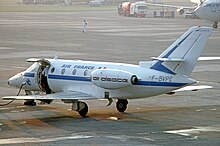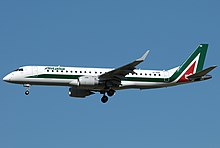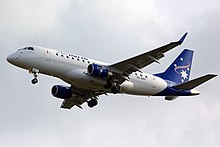SkyWest Airlines is an American regional airline headquartered in St. George, Utah. SkyWest operates and maintains aircraft used on flights that are scheduled, marketed and sold by four partner mainline airlines. The company is contracted by Alaska Airlines, American Airlines, Delta Air Lines, and United Airlines. In all, it is the largest regional airline in North America when measured by fleet size, number of passengers carried, and number of destinations served.
Continental Connection was the brand name under which several commuter airline carriers and their holding companies operated services marketed exclusively by Continental Airlines. As such, all Continental Connection banner carrier services were operated primarily with turboprop aircraft in contrast to Continental Express, whose flights were operated by Continental's regional jet partners, ExpressJet and Chautauqua Airlines. Continental Connection operations were merged into Continental Express in 2012.
Northwest Airlink was the brand name of Northwest Airlines' regional airline service, which flew turboprop and regional jet aircraft from Northwest's domestic hubs in Minneapolis, Detroit, and Memphis. Service was primarily to small-to-medium-sized cities and towns where larger aircraft might not be economical to operate and also to larger markets to either provide additional capacity or more frequent flights than could be justified using mainline aircraft. Beginning in July 2009, the Northwest Airlink trade name was phased out, and replaced by the Delta Connection trade name for Delta Air Lines as part of the Delta/Northwest merger.
Mesaba Aviation, Inc. was a regional airline in the United States that operated from 1944 until 2012, when it merged with Pinnacle Airlines to form Endeavor Air. It was based in Eagan, Minnesota From 2010 to 2012 the airline was a wholly owned subsidiary of Pinnacle Airlines Corp. with code sharing flights operated as Delta Connection for Delta Air Lines and US Airways Express for US Airways. Previously, the airline operated code sharing service as Northwest Airlink and Northwest Jetlink on behalf of Northwest Airlines which subsequently merged with Delta. Mesaba also previously operated connecting flight services in association with Republic Airlines before this air carrier was subsequently merged into Northwest. Mesaba Airlines effectively ceased operations on January 4, 2012, when all aircraft and personnel were transitioned to the Pinnacle Airlines operating certificate. Mesaba's operating certificate was surrendered on July 31, 2012.
United Express is the brand name for the regional branch of United Airlines, under which five individually owned regional airlines operate short- and medium-haul feeder flights.
Air Wisconsin Airlines is a regional airline based at Appleton International Airport in the town of Greenville, Wisconsin, near Appleton. Air Wisconsin originally operated as one of the original United Express partners in 1985, and subsequently operated as US Airways Express on behalf of US Airways prior to becoming an American Eagle regional air carrier. Between March 2018 and April 2023, Air Wisconsin operated exclusively as a United Express regional air carrier once again with primary hubs located at Chicago's O'Hare International Airport (ORD) and Washington Dulles International Airport (IAD). This came to an end in April 2023 as the carrier switched to conducting solely American Eagle branded flights, per a new contract with American Airlines.
Continental Express was the operating brand name used by a number of independently owned regional airlines providing commuter airliner and regional jet feeder service under agreement with Continental Airlines. In 2012 at the time of Continental's merger with United Airlines, two carriers were operating using the Continental Express brand name:
US Airways Express was the brand name for the regional affiliate of US Airways, under which a number of individually owned commuter air carriers and regional airlines operate short and medium haul routes. This code sharing service was previously operated as USAir Express. Mainline carriers often outsource to regional airlines to operate services in order to increase frequency, serve routes that would not sustain larger aircraft, or for other competitive reasons. US Airways Express operations were conducted from smaller markets in the United States, Canada, and the Bahamas primarily centered on US Airways' major hubs and focus cities.
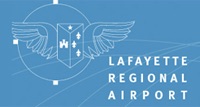
Lafayette Regional Airport(French: Aéroport régional de Lafayette) is a public use airport two miles (4 km) southeast of Lafayette, in Lafayette Parish, Louisiana, United States. It is owned and operated by the City Parish of Lafayette.
Jack Brooks Regional Airport, formerly Southeast Texas Regional Airport, is near Port Arthur, Texas, nine miles (14 km) southeast of Beaumont and northeast of Port Arthur. It was Jefferson County Airport, but its name was changed to honor former U.S. Representative Jack Brooks. The airport is southwest of the city of Nederland in unincorporated Jefferson County, and is used for general aviation. Southwest Airlines ended scheduled jet service in 1980 and several other airlines have started and ended service as well including American Eagle, Continental, Delta/Delta Connection and United Express. The latest chapter is the resumption of service by American Eagle for American Airlines to Dallas/Ft. Worth (DFW).
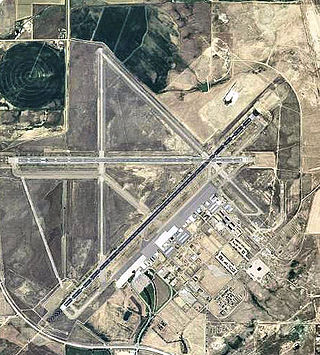
Casper–Natrona County International Airport is 7 miles (11 km) northwest of Casper, in Natrona County, Wyoming. Before December 19, 2007, the airport was called Natrona County International Airport.

Grand Junction Regional Airport is three miles (4.8 km) northeast of Grand Junction, in Mesa County, Colorado, United States. Owned by the Grand Junction Regional Airport Authority, it is the largest airport in western Colorado and third largest in the state, behind Denver International Airport and Colorado Springs Airport.

Durango–La Plata County Airport is a city- and county-owned public airport 12 miles southeast of Durango, in La Plata County, Colorado.
ExpressJet Airlines was a regional airline in the United States that operated from 1987 until 2022. It was headquartered in College Park, Georgia. The company began as Britt Airways and flew exclusively as Continental Express, the contracted codeshare partner for Continental Airlines. The name was changed to ExpressJet at the beginning of 1995 as the company began acquiring Regional jets, replacing its fleet of turboprop aircraft. Along with flying as Continental Express, ExpressJet expanded flying under the Delta Connection brand from 2007 through 2008 and again from 2012 through 2018. Service as American Eagle was flown between 2012 and 2019 and service under the United Express brand began in 2009. ExpressJet also flew an independent operation under their own brand in 2007 through 2008. When Continental Airlines merged into United Airlines in 2012, the Continental Express operations were added to the United Express service. In September 2020, it exited the fee-for-departure airline market and temporarily ceased flights after the conclusion of its contract with its sole remaining mainline partner, United Airlines. In September 2021, ExpressJet resumed operations as both an air charter provider and a regional airline under its own brand aha!—short for "Air-Hotel-Adventure." The brand's route structure focused on the West Coast of the United States with a hub at Reno-Tahoe International Airport, and scheduled flights began on October 24, 2021. The airline, including its brand aha!, filed for bankruptcy on August 23, 2022, having ceased all operations the previous day. In July 2023, the airline announced plans to relaunch as an air charter service using a single leased Boeing 777.
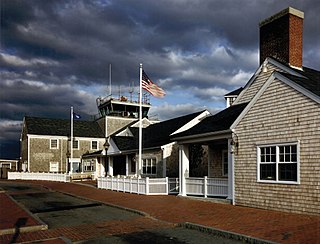
Nantucket Memorial Airport is a public airport on the south side of the island of Nantucket, Massachusetts, United States. It is owned by the Town of Nantucket and is located three miles (5 km) southeast of the town center. It is the second-busiest airport in the state, after Logan International Airport, due to intense corporate travel to and from the island in the high season.

The Florida Keys Marathon International Airport is a public airport located along the Overseas Highway (US1) in Marathon, in Monroe County, Florida, United States. The airport covers 197 acres (80 ha) and has one runway.

A mainline flight is a flight operated by an airline's main operating unit, rather than by regional alliances, regional code-shares, regional subsidiaries, or wholly owned subsidiaries offering low-cost operations. Mainline carriers typically operate between hub airports within their network and on international or long-haul services, using narrow-body and wide-body aircraft. This is in contrast to regional airlines, providing feeder services to hub airports operating smaller turboprop or regional jet aircraft, or low-cost carrier subsidiaries serving leisure markets.
Crown Airways was a regional airline operating for USAir Express with its headquarters on the grounds of DuBois Regional Airport in Washington Township, Jefferson County, Pennsylvania, near Falls Creek. Allegheny Commuter was the brand name for the regional affiliate of Allegheny Airlines, under which a number of individually owned commuter air carriers operate short and medium haul routes. The airline is often credited as the first code-share agreement between a major airline and smaller commuters.

Chautauqua Airlines, Inc. was an American regional airline and a subsidiary of Republic Airways Holdings based in Indianapolis, Indiana, United States. Prior to the shut down of operations, it operated scheduled passenger services to 52 airports in the United States and Canada via code sharing agreements as the Delta Connection for Delta Air Lines, AmericanConnection for American Airlines, and United Express for United Airlines. Chautauqua previously flew feeder services for other airlines via code sharing agreements including Allegheny, USAir, TWA, Continental, Frontier, and America West. Its last day in operation was December 31, 2014, at which time all flying was absorbed by the Shuttle America certificate.
Delta Connection is a brand name for Delta Air Lines, under which a number of individually owned regional airlines primarily operate short- and medium-haul routes. Mainline major air carriers often use regional airlines to operate services via code sharing agreements in order to increase frequencies in addition to serving routes that would not sustain larger aircraft as well as for other competitive or operational reasons.




